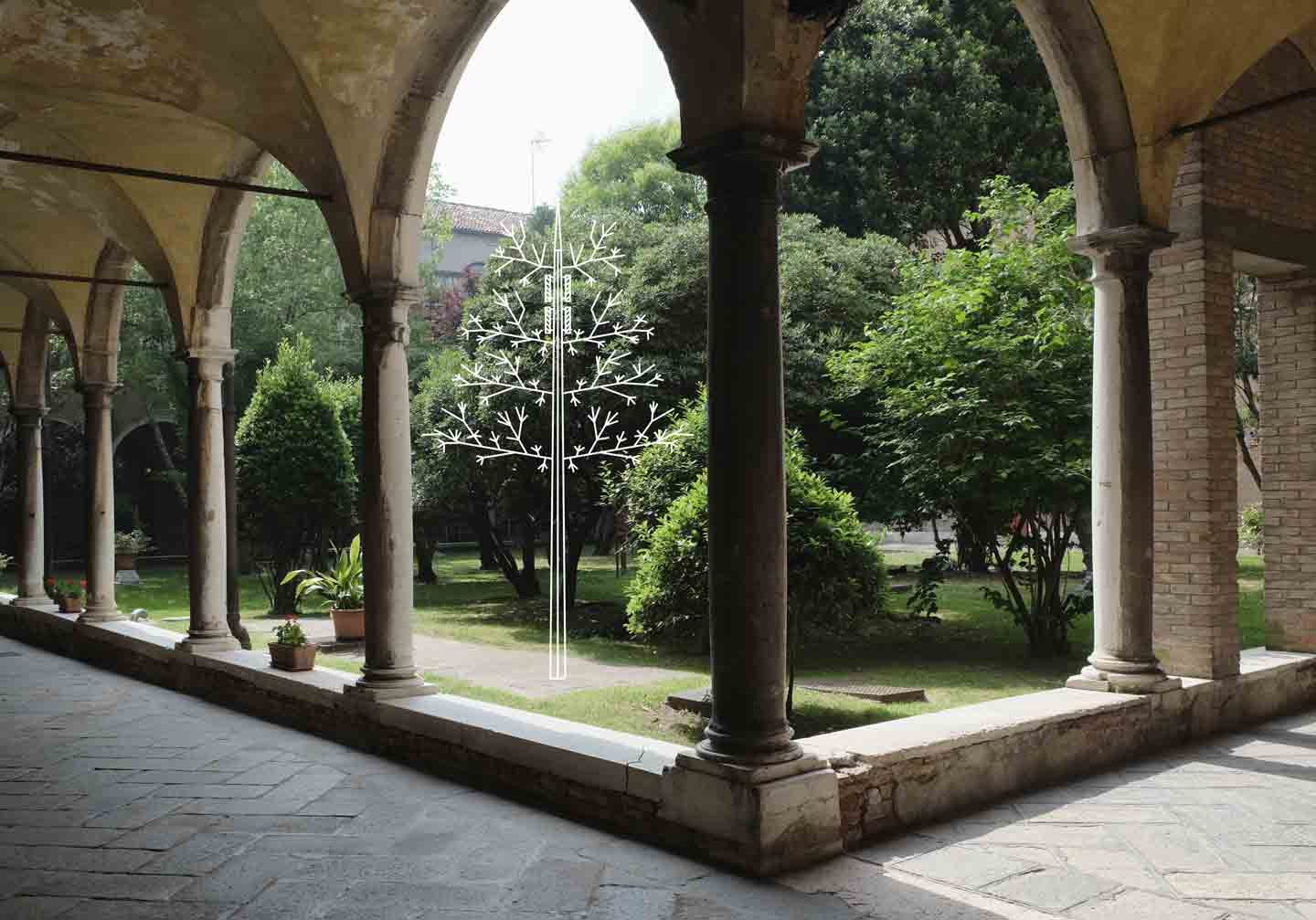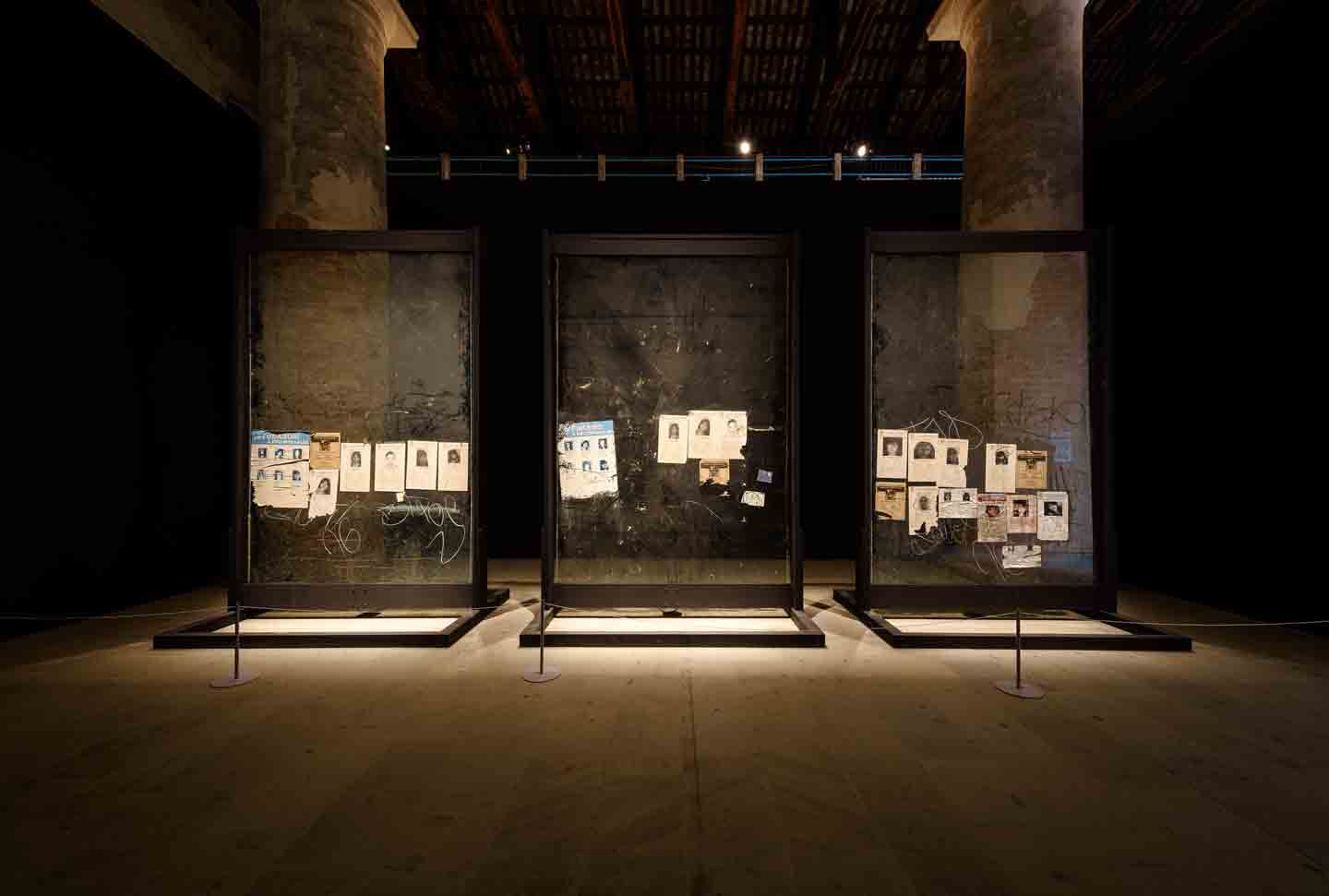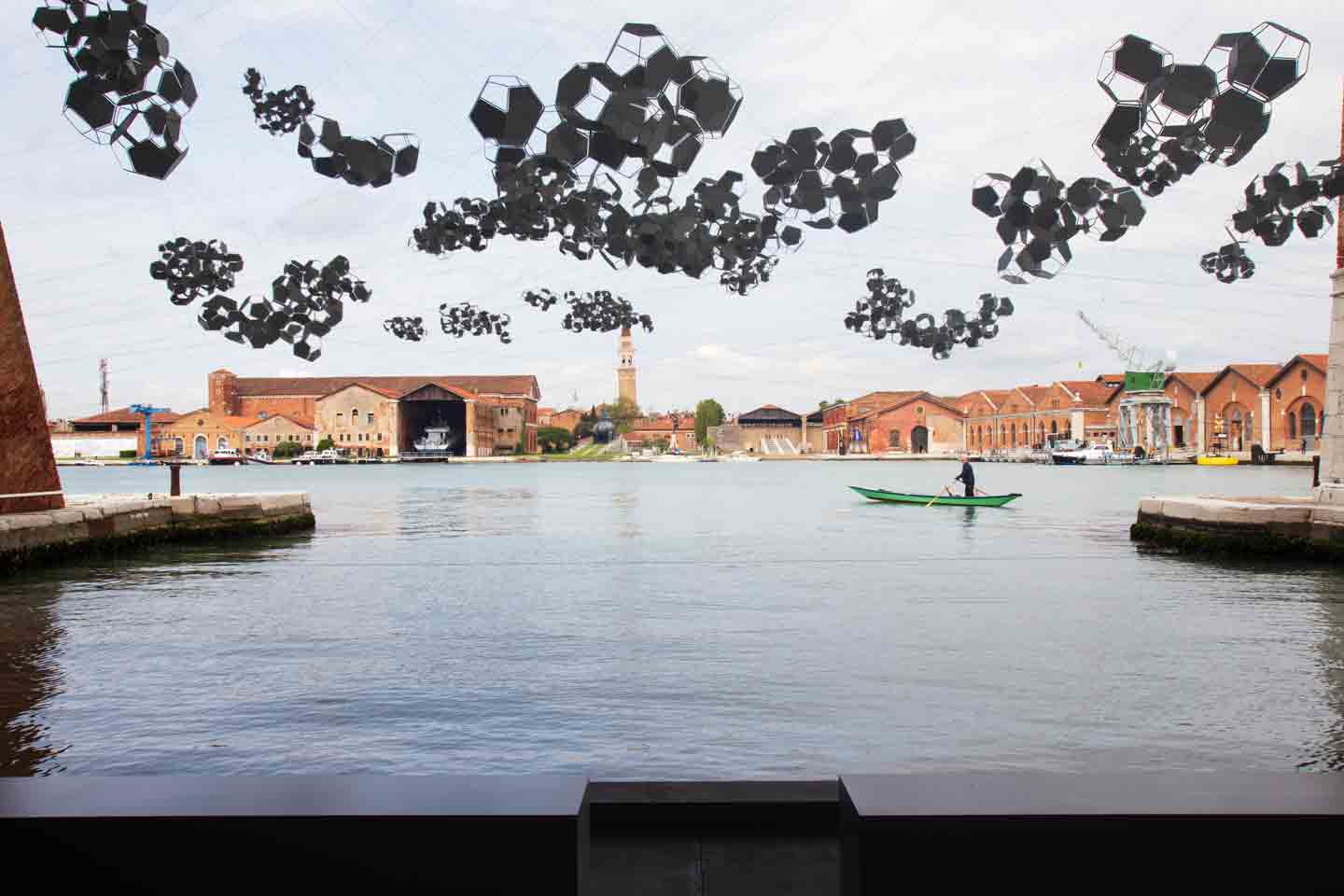Venice is a map-proof city: Even with directions in hand, I find myself looking for paths that seem not to exist in reality. In some cases, between dead-ending into green canals and walking past the tunnel-like turnoffs I was supposed to walk down, it takes me longer to find a given building than it does to examine the art it contains. I had come to La Serenissima for the Biennale Arte, which has swamped the city—with a few wartime exceptions—every two years since 1895, bringing some half a million visitors this year for the current incarnation of the six-month international spectacle, one of the premier events on the art world’s calendar.
The Biennale has always been political: Begun to fete the wedding anniversary of Italy’s king and queen, the exhibition in its early days was a way of using art to solidify a sense of national identity at a time when Italy’s status as a unified entity was still relatively new. After the Fascists seized power, they appointed Giuseppe Volpi (former colonial governor of Libya) to head up the show, which began consciously courting a broader audience with the goal of disseminating fascist ideas through mass culture. This tincturing of art with ideology continued into the postwar period, when Italy’s government did away with exhibition committees heavily populated by communist unionists and began to favor abstraction over leftism-tinged neorealist styles. For the 58th Biennale, the curators have brought politics to the fore with a theme that suggests an exploration of the flawed futures we make for ourselves.
The wording of this year’s theme, May You Live in Interesting Times, has garnered criticism from various quarters—from Cosmin Costinas of Hong Kong’s Para Site art center and the Guggenheim’s Weng Xiaoyu for knowingly perpetuating an orientalist trope (early promotional materials branded the phrase an “ancient Chinese curse,” though its earliest known use dates to a British political speech from the 1930s), from Claire Bishop in Artforum for being quite simply “a lousy curatorial premise.” Tin-eared phrasing aside, a strong metric of any theme is the degree to which it provides artists with conceptual fodder. The main events of the Biennale are housed in two venues: the Giardini, a wooded park where exhibition pavilions sprout like mushrooms, and the Arsenale, the Navy-yard-slash-art-space from which Venice’s fleets once dominated the Mediterranean. In addition to these principal areas, auxiliary pavilions are woven throughout the city, occupying various palazzi, castelli, and academie across the Venetian lagoon.
These outlying events are what I focus on for my first day at the festival, the highlight of which is the New Zealand pavilion housing Dane Mitchell’s Post hoc. Wi-Fi towers constructed as faux pines offer those on the grounds of a canalside manor access to an eerie soundtrack of things disappeared, read in an eerie monotone: extinct languages (Harappan, Old New French), outmoded words (“augie,” “afore,” “alee”), vanished sounds (the caw of a moa, the sound of a rotary telephone dialing). Walking out of the pavilion and down a street clogged by recently debarked cruise-goers, I listen as the otherworldly voice intoned a series of obsolete medical terms. “Delerium tremens,” it hums. “Distemper. Dypsomania.”
Popular
"swipe left below to view more authors"Swipe →
The rhetorical success of Mitchell’s quietly mournful elegy to the deaths and disappearances attendant upon the Anthropocene lies in its ability to insinuate itself into the fabric of the viewer’s experience: Provided our earbuds are still in, the chantlike enumeration of the dead stays with us as we leave the grounds, as we pass the neighboring buildings, аs we twist and turn down whichever serpentine alleys will take us to our next destination, In the process, it shapes our perception of what we pass, attunes us to its impermanence, to the sinking marshland soil and the ever-rising tides that will one day, perhaps, consign Venice to this catalogue of the vanished.
Such a way of working is reversed in Chris Büchel’s Barca Nostra, which I encountered as I made my way to the dockyards of the Arsenale. One of the most talked-about (and controversial) works in this year’s show, Büchel’s piece consists of the hulking, dredged-up remains of a coffin ship on which hundreds of African migrants died trying to cross the Mediterranean. Intended as both a memorial and a provocation, the work’s lack of clear signage (which was removed at Büchel’s insistence, meaning that only those who shell out for the expensive catalogue can access an explanation of the work) and its location near a Biennale cafe have allowed it to become at best a solemn backdrop to overpriced lunches and at worst a selfie op. Rather than altering the course of the everyday (as with Mitchell’s piece), the ship is assimilated into and engulfed by the quotidian existence of the unwitting showgoer as they sip coffee and lounge in the sun.
For many of the Biennale’s artistic responses to current events, presences register less than absences: that which betokens without being there. Mexican forensic-scientist-turned-artist Teresa Margolles, whose corpus of Biennale works are a response to the femicides in the borderlands, achieves more with her piece La Búsqueda—in which the sound of a Juárez train produces a haunting groan as it rattles glass panels plastered with photos of missing women—than she does with her more direct Muro Ciudad Juárez, for which the artist transported and rebuilt a bullet-pocked wall from the namesake city.
In other cases, the most eloquent absences are those that occur by accident: In the Ukrainian pavilion, a hangar-like space whose emptiness dwarfs the collection of desks arranged within it, I strike up a conversation with Mariana Yaremchyshyna, a performance artist staffing the gallery. The core of the piece is not here, she explains: Instead, it is composed of a hard drive containing the names of all Ukraine’s artists that was supposed to have been flown over the Giardini on the opening night of the Biennale, casting a shadow that would symbolically assert all of their presence at the event. As she speaks, I’m struck by her use of the hedging formulation “supposed to.”
“So it didn’t happen?” I ask.
“Well—”
The flight, she explains, had been scuttled for a number of reasons: The weather on the day could not be guaranteed to have enough sunshine to cast the required shadow; Venice, a UNESCO Heritage Site, was subject to numerous cultural protection laws, including flight path limitations; the Italian government had issued a statement weeks prior to saying that they had never received Ukraine’s request for the project and would therefore have to deny it; and the intended aircraft required such serious repairs that it would never be airworthy by the Biennale opening. Nevertheless, she said, the plan went ahead, and at the opening gala Ukrainian officials could be seen peering up at the sky and declaring that they saw the plane. The original plan may have failed–but it was a failure that painted a vivid caricature of Ukrainian bureaucratic breakdown.
The morning I make my way to the Giardini, I find that a group of Jehovah’s Witnesses, in sensible dresses and long-sleeved shirts that must be punishing in the already-mounting morning heat, have arrayed themselves around the ticket booths, evidently in the hope that one or two Christian Marclay fans would jump the contemporary art ship and find Jesus. The pavilion-dotted Giardini is more than any other part of the Biennale a fossilized remnant of the show’s beginnings as an artistic horse race between nations seeking to transpose their imperial struggles for dominance onto the cultural arena.
While newcomer nations are left to struggle for limited real estate offered at sky-high prices (rents in temporary spaces can account for over half of some countries’ show budgets), those countries wealthy enough to have staked a permanent claim of their own have entire purpose-built exhibition halls to themselves. These attempts to channel putative “national essences” in brick and mortar come with mixed results. The Hungarian pavilion is awash in gold mosaics; the German pavilion is a severe Nazi-era holdover; the Belgian pavilion looks like something from The Flintstones.
Is the Biennale inevitably nationalistic? A certain atmosphere of jockeying seems unavoidable in so high-profile an event, which feels in some ways continuous with the early 20th century’s inclusion of competitive painting at the Olympics. Perhaps this year’s only entrant to really push against the nationalistic nature of the international art expo is Greece, in a somewhat scattered display that nevertheless brings to the expo something that its flashier and more focused neighbors do not. “How does one approach a national pavilion in an era of volatile national identities, quick shifts, and radical changes, when the concept of nation-states as we know it is being disputed—and simultaneously intensified through extreme permutations?” asks the wall text. At the center of the gallery is Zafos Xagoraris’s exploration of Greece’s 1948 Biennale showing, during which the rightist Greek government (then in the midst of a civil war) gave its pavilion over to Peggy Guggenheim’s star-studded art collection at the same time as it was forcing POWs to build models of ancient monuments for the purposes of reeducation. Through archival work and sculpture, Xagoraris offers a direct statement about the Biennale’s soft power and the ways culture is wielded to spackle over political crimes.
As my time at the Biennale wears on, I find myself wondering at how few artists have taken on the theme of climate change (surely one of the major points of “interest” in these “interesting times” of ours). Are there classes of problems that cannot be dealt with meaningfully through artistic means? Does rendering the manifold disaster of climate change bring us to the edge of what is artistically imaginable at a venue such as this one? If this Biennale’s offerings provide a range of responses to the many crises of our times, perhaps they also invite us to consider the limits of political art making. (And it is difficult not to notice, too, the waste produced by the festival: legions of disposable espresso cups, plastic coffee stirrers, and of course the forest of leaflets and handouts printed on fancy paper.)
All the same, there were some artists who took up the challenge. Lithuania’s Sun & Sea (Marina), an indoor beach opera that touches on themes such as mass extinction and coral reef death, took this year’s Golden Lion, the Biennale’s top prize. Another notable exception is Tomás Saraceno. In Acqua Alta en clave del Sol, the artist uses Venice’s flood alarm system (in which severity is graded by pitch) as a jumping-off point to imagine the eerie soundscape of the future. By turning to the sonic instead of the visual, Saraceno is able to bypass the numbing familiarity of images and create a work capable of inspiring genuine horror.
Though I dwell on the festival’s imagined dystopias, there is something utopian about the Biennale, something thrilling about a season during which whole buildings are given over to art and those who love it. Art shows are often derided (certainly not without cause) as pretentious affairs, but there is within them all the same the possibility of anti-pretention. The outlying pavilions, unticketed and free to all, make possible a more casual relationship with art, one in which seeing a work one loves can be as simple as ducking into a building during one’s lunch break instead of making a grand occasion of it. Much of May You Live in Interesting Times asks us to think deeply about darknesses past and present––but what other futures might we dream?





